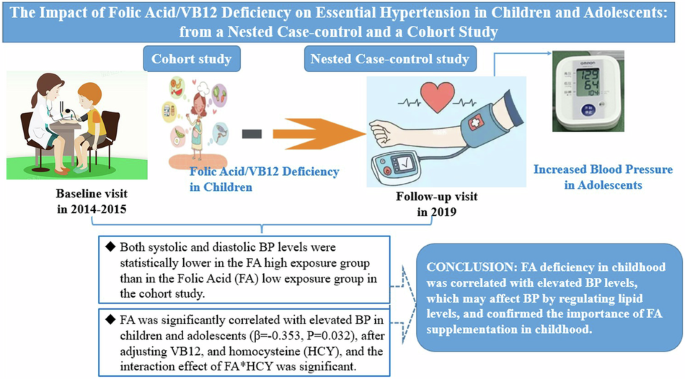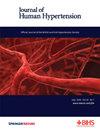The impact of folic acid/VB12 deficiency on essential hypertension in children and adolescents: from a nested case-control and a cohort study
IF 3.4
4区 医学
Q2 PERIPHERAL VASCULAR DISEASE
引用次数: 0
Abstract
To explore the relationship between serum folic acid (FA) or Vitamin B12 (VB12) and elevated BP in children and adolescents. Both a nested case control and a cohort study were designed to explore the relationship between serum folic acid (FA) or Vitamin B12 (VB12) and elevated blood pressure (BP). All the included participants were from primary school. A total of 326 subjects (116:210) in nested case control were from an established cohort. And 270 participants without hypertension at baseline and followed in 2019 in cohort. FA and VB12 levels were lower in the elevated BP group than in the control group, and homocysteine level was higher than that in the control group. In the elevated BP group, overweight/obese children had lower FA than overweight/obese children in the normal BP group. FA was positively correlated with high-density lipoprotein (HDL) and Apo lipoprotein A (APOA), but negatively correlated with triglyceride (TG). FA was significantly correlated with elevated BP in children and adolescents (β = –0.353, P = 0.032), after adjusting VB12, and homocysteine (HCY), and the interaction effect of FA*HCY was significant. Both systolic and diastolic BP levels were statistically lower in the FA high exposure group than in the FA low exposure group in the cohort study. This study found that FA and vitamin B12 deficiency in childhood was correlated with elevated BP levels, which may affect BP by regulating lipid levels, and confirmed the importance of maintaining high levels of FA and vitamin B12 in childhood either by diet or supplementation.


叶酸/VB12 缺乏对儿童和青少年原发性高血压的影响:从巢式病例对照和队列研究中得出的结论
探讨儿童和青少年血清叶酸(FA)或维生素 B12(VB12)与血压升高之间的关系。为了探讨血清叶酸(FA)或维生素 B12(VB12)与血压(BP)升高之间的关系,我们设计了一项巢式病例对照和一项队列研究。所有研究对象均来自小学。在嵌套病例对照中,共有 326 名受试者(116:210)来自已建立的队列。队列中有 270 人基线时没有高血压,但在 2019 年接受了跟踪调查。血压升高组的 FA 和 VB12 水平低于对照组,同型半胱氨酸水平高于对照组。在血压升高组中,超重/肥胖儿童的 FA 值低于血压正常组中的超重/肥胖儿童。FA与高密度脂蛋白(HDL)和载脂蛋白A(APOA)呈正相关,但与甘油三酯(TG)呈负相关。在调整 VB12 和同型半胱氨酸(HCY)后,FA 与儿童和青少年的血压升高明显相关(β = -0.353,P = 0.032),FA*HCY 的交互效应也很明显。据统计,在队列研究中,高 FA 暴露组的收缩压和舒张压水平均低于低 FA 暴露组。这项研究发现,儿童期缺乏足量脂肪酸和维生素 B12 与血压升高有关,这可能会通过调节血脂水平来影响血压,并证实了在儿童期通过饮食或补充剂维持高水平足量脂肪酸和维生素 B12 的重要性。
本文章由计算机程序翻译,如有差异,请以英文原文为准。
求助全文
约1分钟内获得全文
求助全文
来源期刊

Journal of Human Hypertension
医学-外周血管病
CiteScore
5.20
自引率
3.70%
发文量
126
审稿时长
6-12 weeks
期刊介绍:
Journal of Human Hypertension is published monthly and is of interest to health care professionals who deal with hypertension (specialists, internists, primary care physicians) and public health workers. We believe that our patients benefit from robust scientific data that are based on well conducted clinical trials. We also believe that basic sciences are the foundations on which we build our knowledge of clinical conditions and their management. Towards this end, although we are primarily a clinical based journal, we also welcome suitable basic sciences studies that promote our understanding of human hypertension.
The journal aims to perform the dual role of increasing knowledge in the field of high blood pressure as well as improving the standard of care of patients. The editors will consider for publication all suitable papers dealing directly or indirectly with clinical aspects of hypertension, including but not limited to epidemiology, pathophysiology, therapeutics and basic sciences involving human subjects or tissues. We also consider papers from all specialties such as ophthalmology, cardiology, nephrology, obstetrics and stroke medicine that deal with the various aspects of hypertension and its complications.
 求助内容:
求助内容: 应助结果提醒方式:
应助结果提醒方式:


